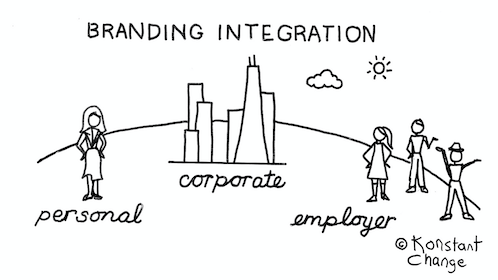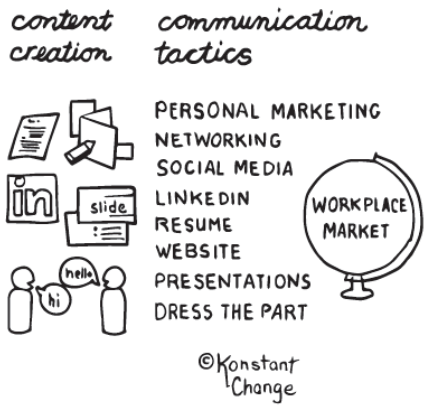
Have you considered how brand integration—personal, employer, and corporate—will increase your value to both you and your company?
This is one of a series of articles on the many facets of personal branding for the workplace. Refer to a previous article to understand why every professional needs to build a personal brand.
I’m usually not one to dispense dating advice, but when it comes to your career management, there are three entities whose relationships are simply better together:
- Personal branding = marketing and positioning of you
- Employer branding = marketing and positioning of a company to a specific group of people for purpose of attracting and retaining talent; potential or existing employees
- Corporate branding = marketing and positioning of a company to a broad group of stakeholders: potential/current customers, investors, media, business partners, and employees
Just like collaborative teams yield a more noticeable and timely result than one person working solo. Similarly, a significant personal brand increases in value when combined with employer or corporate brands. Conversely, employer and corporate brands expand their worth when integrated with smart personal brands.
Personal Branding + Employer Branding + Corporate Branding
Here is the rule of thumb: Harmonize branding efforts for greater impact.
The attraction between individual and corporate brands form a productive bond, yielding mutual benefits.

Using marketing programs as an example, it has long been known three (or more) marketing campaign tactics work better than just one. This approach is referred to as integrated marketing. It creates better results for companies than isolated tactics, like advertising, email, or public relations.
The reason is each activity, working in concert with one another, amplifies the results of a related activity. The return on investment (ROI) is greater than when three activities are launched in isolation. An integrated campaign with optimal timing achieves exponential results.
Examples of Brand Integration
Richard Branson
As a leader of more than four hundred companies within Virgin Group, Richard Branson’s brand is synonymous with:
- Multipreneurism
- Humanitarian instincts
- Anything is possible
- Taking risks
- Persistence Solving burning problems
- Thinking big
Some of these personal values overlap with corporate values.
Branson’s genius is visible via his devout interaction with the entrepreneur community. He holds contests and publishes articles in countless publications. Readers want to understand how to work, create, and be successful entrepreneurs.
His speeches on risk taking and failure are classic lessons for people and companies who want to grow. As founder and motivational leader at Virgin, he is the flag-carrying champion of the company.
Richard Branson’s brand is estimated at multiple times the value of the Virgin brand. This value amplifies the impact of the employer brand (the ability to attract talent) and corporate brand (the value of the company).
You
 You might be curious if there are other examples demonstrating this type of integration. The answer is anyone, including you, can reflect the value of a corporate brand, while increasing your business presence. For example, you might be speaking at an industry conference as a representative of your company.
You might be curious if there are other examples demonstrating this type of integration. The answer is anyone, including you, can reflect the value of a corporate brand, while increasing your business presence. For example, you might be speaking at an industry conference as a representative of your company.
As of result, your speaking role makes you a subject matter expert and an ambassador for your company or product. This is a valuable benefit to you and your employer.
Additionally your personal market value as an industry professional expands with your business exposure. Through conference marketing materials and your presentation, people in the audience get to know you. You will educate them about your organization and potential employees take an interest in your company.
The Way We Were
Until recently, each type of workplace branding was a separate, siloed operation. Many employers viewed personal branding with suspicious eyes.
The company point of view was further complicated by trust and loyalty issues. Employers were more interested in employee value within their organization, rather than individual value on the open or external market.
A high potential employee could quickly become a threat as her star rose and she became more valuable in a particular industry. An employee groomed by one company could turn into a free agent. A completing company could provide a spicy offer. The balance between positive reinforcement and keeping significant contribution under wraps created tension and mixed signals.
Before the employer-employee compact changed, a term introduced via Reid Hoffman and Ben Casnocha in their book Start-up of You, freelance efforts were forbidden. Corporations viewed side gigs, an expression of an individual brand, as a betrayal of company loyalty.
Companies focused on their own brands, rather than focusing on individual brands. This is still true in many businesses today, but is changing rapidly to conform to the evolution of the work environment.
The world of work is changing; adapt or get left behind. As a result, this advice is relevant for corporations and individuals.
Although each workplace branding style has different agendas, they form a synchronous relationship.
- Personal branding: differentiate individuals
- Employer branding: attract and retain best available talent
- Corporate branding: build and reinforce value of company in minds of customers, stockholders, and other stakeholders.
And finally, there are five unmistakable benefits for companies who embrace personal brand champions among their ranks.
Benefits of Personal Brand Champions in Corporations
Corporate advocacy
The corporate advocate speaks on behalf of her company at an industry conference initiates a set of complementary branding results. She reinforces her business expertise across a broad group of industry participants, increasing her value as a thought leader. She also expands positive company awareness, strengthens the corporate brand, and attracts potential employees who may be in the audience. A solid win for all three types of branding.
Social skills
Today’s job candidates are rigorous researchers, an important trend impacting employer brands. Job seekers have access to the largest database of online information via their browser when vetting a potential employer. Companies who support and encourage personal brand activities via social media will reap the rewards of positive searchable content about their business.
Personal publisher
Most noteworthy is that employees create a lot of content! Employees are prolific publishers of content like speeches, industry blog posts, white papers, technical briefs, presentations, and videos. Employees produce this content in alliance with corporate or product marketing departments, yet the author signature is a display of the personal brand. As a result, personal brand awareness is transparently integrated with corporate and employer brands.
Leadership branding
Because leaders in the C-suite bear a similar responsibility to corporate and employer brands, they bear the burden of clear communication and correct responses. Online access by customers and investors to videos, speeches, and quotes in the media represent influential data points for a company brand. Media training and coaching is an essential part of brand management for executives. A CEO’s personal brand and her public interaction with customers is an extension of the corporate public persona.
Talent recruitment
Recruiters, hiring managers, and human resources leaders look for culture fit and online social footprint, along with the many skill requirements necessary to fulfill a particular position. As they sift through the vast mountain of applicants, the standouts rise to the top because of aligned personal brand definition. Hiring decision makers apply the company brand filter as a vetting tool for choice.
In conclusion, the trio of branding efforts are better together.
In my book, Activate Your Agile Career, I include many examples of personal branding dovetailing to corporate and employer branding. For more resources in achieving this three-part harmony between personal, corporate, and employer brands, subscribe to Marti’s 52 Ideas. For more details on career agility, check it out here.
